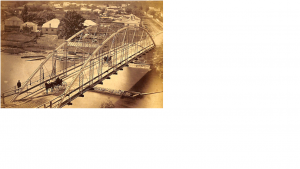
London Ontario bridge and sewer designated historical sites
June 6, 2016
By
CCE

Blackfriars Bridge, London, Ontario shortly after it was built in 1875. Image: Stanford University Libraries, Dept. Special Collections.
The Canadian Society for Civil Engineering (CSCE/SCGC) has designated two structures in the city of London in southwest Ontario as National Historic Civil Engineering Sites. A ceremony was held at the Blackfriars Bridge historic site on June 3.
Blackfriars Bridge is an 1870s-era structural innovation fabricated by the Wrought Iron Bridge Company of Canton. It is one of few such bridges still standing in the world. Built at a time when wood bridges were frequently being replaced with wrought iron structures, the London bridge has a through arch-truss with a 68.4-m span.
The other project in London to be designated was the 100-year old Egerton Street Double Sewer. Built in 1914-1918, the 1,700-ft sewer was first promoted by Willis Chipman who helped to design it. The sewer is 25 feet below grade and unusual for its time because it has a double configuration with storm flows and sanitary flows separated within it. CSCE says that due to its rare design, it is a hallmark example of the benefits of civil engineering to public health.
Tony Bégin, President of the CSCE, said: “The CSCE is very pleased to recognize the Blackfriars Bridge and the Egerton Street Sewer as National Historic Civil Engineering Sites,” said. “Both are worthy examples of complex and pioneering engineering projects which continue to be studied by many other people across the globe as innovative approaches to dealing with unique situations.”
London Mayor Matt Brown, said: “Today, we are thrilled to be recognized for these two extraordinary structures, both testaments to the importance of civil engineering here in London.”
“Being able to celebrate not one, but two feats of civil engineering here in London is proof of our culture of innovation, stability and sustainability,” said John Braam, Managing Director and City Engineer for the City of London and CAO for the Regional Water Supply Systems. “We continue to develop and foster this culture among our many engineers and engineers-in-training, and continue to see amazing results.”
The mandate of the committee responsible for the History Program established in 1983 by the Canadian Society for Civil Engineering is to record and preserve whatever tangible evidence remains of the significant works of earlier generations of Civil Engineers, and through suitable publications and publicity, to make the general public and even engineers themselves, more aware of the importance of Civil Engineering in the historic development and welfare of Canada. To date, over 40 works of local, regional, national and international historical significance have been dedicated.
To read the City of London press release, click here.
https://www.london.ca/newsroom/Pages/CSCE-Designations.aspx
To read articles about the two sites in CSCE’s CIVIL magazine, click here (pages 12 and 16)
https://csce.ca/publications/cce/